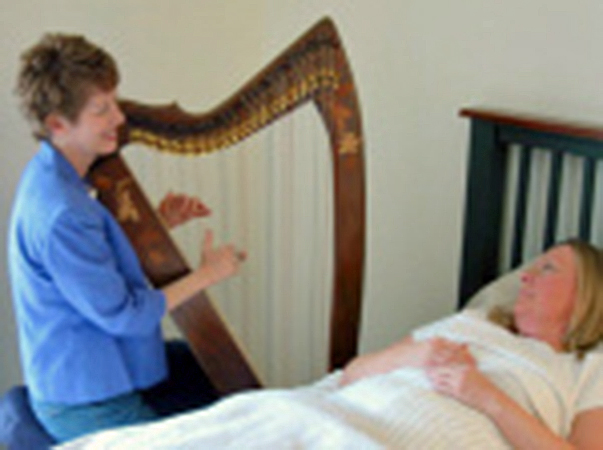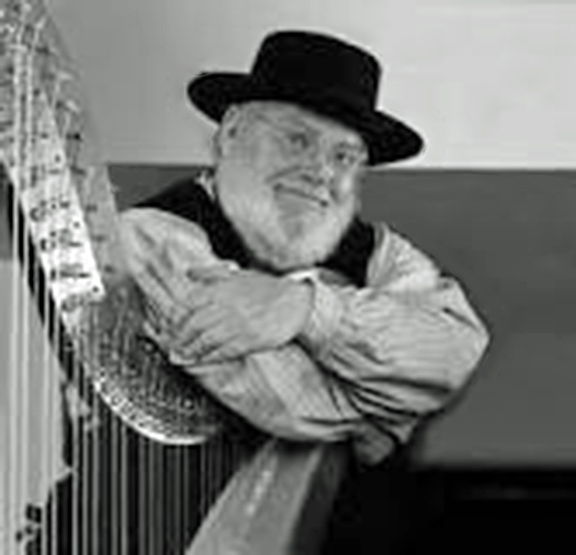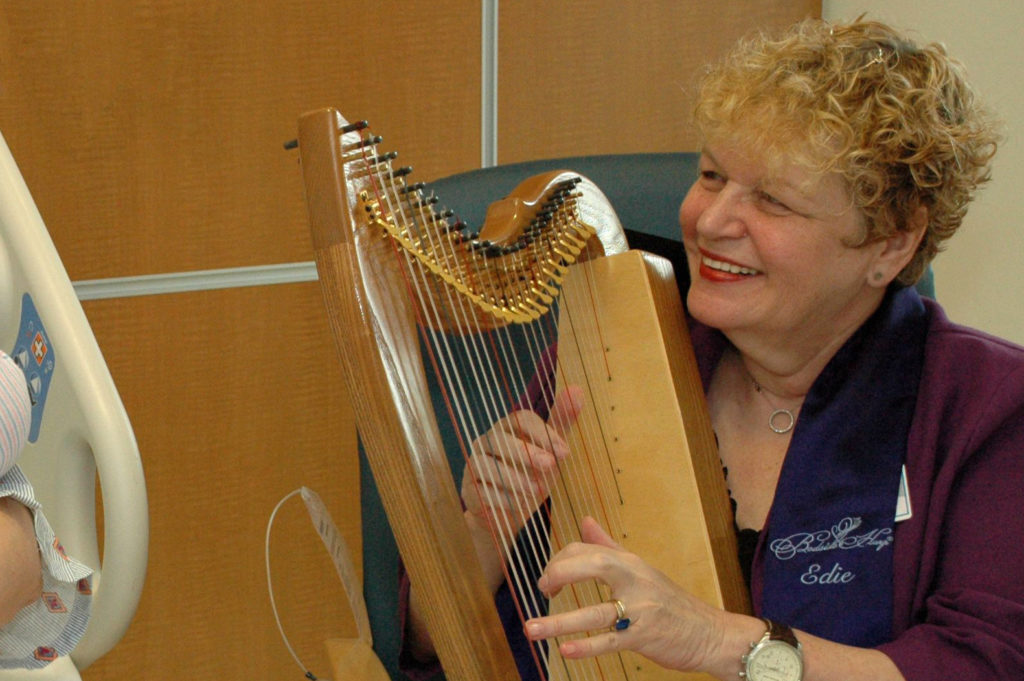














The Therapeutic HarpCompiled by Joyce Rice, with many thanks to Laurie Riley “Music can name the un-nameable and communicate the unknowable.” ~Leonard Bernstein You may have heard about the healing powers of harp music. It’s not a new concept. 2500 years ago, the Greek philosopher and mathematician Pythagoras recommended lyre music to keep his patients healthy. In Africa, griots helped connect people to the spirit world with their harp (kora) playing. And King David was said to play his harp (lyre) to raise the spirits of King Saul. (King James Bible: “And it came to pass, when the evil spirit from God was upon Saul, that David took an harp, and played with his hand: so Saul was refreshed, and was well, and the evil spirit departed from him.” Samuel I 16:23) Below are a few more recent experiences.Harpist Joyce Rice “Late one afternoon I was playing cocktail music at a TGIF event in a huge converted barn, and I happened to notice a woman leaning tiredly against a large rustic beam at the other end of the room. A half-hour later when I was between pieces she approached me and said, ‘This has probably been one of my worst work weeks. Thank you so much for making me feel better with your music!’” Therapeutic harp pioneer Laurie Riley (https://laurierileymusic.com/therapeutic-music-resources/)
Laurie Riley and a patient “One evening in 1990, long before bedside music was used in hospitals for other than hospice patients, and before any certification programs yet existed for it, I learned that my father had pneumonia and was in Intensive Care. I packed my bag. At the last minute, I decided that since he was only semiconscious, perhaps the best way for him to know I was there would be to play my harp for him. I put it in the car. At the hospital, I found him hooked up to monitors, tubes, and machines. I asked his nurse if I could play for him, and because a harp in a hospital was unheard of at the time, she said bluntly, “For five minutes.” After five minutes passed, no one told me to stop, so I kept going. I began to hear whispers from the nurses. “It must be the music...” Soon, a doctor tapped me on the shoulder and whispered words that would soon create a big change in my life: “Pythagoras said music heals. Please don’t stop.” I was surprised to hear this from a doctor, and happy to continue as she asked. I kept playing, and the monitors showed improvement in my father’s vital signs; he breathed more deeply and his pulse became more regular. Whenever I paused, alarms buzzed and care personnel came scurrying. It seemed like a good idea to comply with the doctor’s wishes and not stop at all. The family had been told that my father would not make it through the night. I played late into the night, and then stood at his bedside to whisper my final good-bye. I went to sleep on a cot in his room. When I woke at sunrise, the sound of the heart monitor steadily beeping seemed the finest thing I’d ever heard - he was still alive! I got up and played some more. As the days passed, I played as much as possible, and my father improved daily. It was made clear by the medical staff that I had become part of his healing team and that my efforts were important. I assumed at the time that the music made a difference because I was his daughter and we therefore had a connection. But the nurses and doctors asked me to play for other patients in ICU, and there were positive effects for them as well. What I would never have expected was how this experience made me feel. Being present in a place where life was tentative and where, every minute of every day, amazingly dedicated people were saving lives, gave me a sense of what’s truly important: love and connection. I felt more alive there than at any other time or place. I stayed for a week, playing for several hours each day and often late into the night. The nurses and doctors told me again and again that the music was making a positive difference for the patients, and for themselves, too. At the end of the week, my father was transferred to general care to complete his recovery.” Therapeutic harpist Monica Schley (https://monicaschley.com/other-services/) “Recently, I played for a man suffering from cancer, who was originally from Peru. South American culture is rich in upbeat rhythms. When I arrived playing my small Irish harp (nothing like the Peruvian harp), playing airs and American folk songs, he wanted something much more peppy with quick chord changes. It is atypical for me to play music at a quick tempo at the bedside, yet that is what this client wanted. When I switched styles, he visibly cheered up. It is imperative to look at the patient and harmonize with what they need to hear. If their facial expressions show they’re displeased, you should change what you are playing, maybe even stop. The quick-paced songs that this client wanted were reminiscent of his youth. That is what made him happy, and that is partially what therapy music is about. ”
Monica Schley and an appreciative patient “Another time I played for a 95 year-old woman with dementia who became very emotional when she heard the harp. Her shoulders slumped and she appeared melancholy. When I saw she was crying, I switched to a popular soothing musical choice for harpists – traditional Celtic tunes. She didn't stop crying. Then, I realized that she must have been experiencing feelings deep inside that couldn't be expressed otherwise. With her more progressed dementia, she could only speak in “word salad,” a sort of unintelligible garble that must have frustrated and frightened her, but the music was helping those repressed feelings be released. When her daughter asked her if she'd like me to stop playing, she said no. Her tears were her release and relief.” Therapeutic harpist April Mitchell “The room was silent as the first notes were strummed and a melody of a gentle hymn was forming. The music traveled from the strings to the patient, and surrounded her family. Then one by one voices spontaneously joined each other in song until the room was booming with the joy of a family singing to their loved one who was passing. The soft notes of the harp guiding the way… This is why I play. A tired mother was kept in her hospital room, deprived of her two kids, for the second week with uncontrollable itching plaguing her. The soft gentle sounds of the strings echoed on the walls as it lulled the mother into a deep relaxation. As the itching stopped and her breathing slowed, her husband said, “This is the most relaxed she has been in two weeks!” And I smiled… for this is why I play. Patients have said that my music has “taken away the pain”, “is better than medication", “took away their stress” and “brought peace”. Nurses see oxygen levels increase and heart rates lower… and this is why I play! This work calls to me. The music guides me and all who are in her path. Music speaks through sound and I watch as her magic swirls around, touching every soul and bringing rays of hope. This is why I play.” Relaxation, recovery, reminiscence, release: four wonderful outcomes. Mine came as a pleasant surprise; Laurie’s came from wanting to comfort; Monica’s and April’s were part of their jobs as therapeutic harpists. Why is harp music so special in these settings?
Ron Price
See
a video of harpists playing at the Robert Wood Johnson University Hospital
at Rahway, NJ: Does therapeutic harp interest you?First off, it’s helpful to know that there are Music Therapists and Therapeutic Musicians. As Laurie Riley explains in The Work of Certified Music Practitioners: Therapeutic Music in Medical Settings: There are two general types of certified musicians who work in medical environments. The American Music Therapy Association owns the title Music Therapy, so those certified from other organizations must use other titles and are generally referred to as Therapeutic Musicians rather than Music Therapists.
The work of certified therapeutic musicians is a “passive” therapy, which means no interaction is required or solicited from the patient. Those graduating from accredited programs are qualified to play for patients in ICU, CCU, NICU, ER, Post-op, oncology, and general care. This work is not entertainment or performance; the focus is entirely on the patient, who is not required to interact, especially since patients who are very sick, anesthetized, medicated or comatose are usually unable to do so. (Yes, the effects of certain kinds of music have been shown to benefit even patients who are not conscious.) Why a training program?Laurie continues: A common question is, “Why do I need to be trained just to play music as a heartfelt service for a sick person?” This deserves a thoughtful answer. First, anyone may play music for a sick friend or family member at home, or with permission for a sick friend you are visiting in a medical institution. But within a medical setting, playing in an official capacity puts you in a different position. Although it may seem that anyone who plays well should be able to play for a patient in a medical setting, there are codes of deportment within medical institutions that are not the same as elsewhere; what is normal, polite deportment in the world outside the medical facility may not be at all appropriate within. To function well in such environments one must also have a working knowledge of corporate compliance. Additionally, anyone working in an official capacity in a medical setting must be familiar with codes and ethics, emergency procedure, and the like. That, plus understanding how specific kinds of music affect the body and psyche on a scientific level as well as emotionally and psychologically, is why training programs exist, which ensure that you will be knowledgeable and confident as you do your therapeutic musical work. The skills of the practitionerIn care settings, the harp not only brings joy to the people living there, but can also give a few moments of calm to the working staff. The music can dramatically change the overall atmosphere.
****************
“Sometimes we point to the harp and say, “This is medical equipment,” which often elicits a smile or a chuckle. Most people get it. The soothing sound of the harp reduces anxiety, helps people rest, created a sense of peace, and is completely safe. Harps belong in hospitals!” From March 30, 2017 article from Providence Health and Services/Washington.
Edie Elkan of Bedside Harp Would you like to learn more about being a therapeutic musician? Presently there are four programs that meet basic training standards set forth by the National Standards Board for Therapeutic Music.
Want more information?List of programs, conferences, webinars, therapeutic music publications, books about playing at the bedside at Soothing Harp https://www.soothingharp.com/therapeutic-music-resources by Karen Peterson Below are resources from Sarajane Williams, Publishing Editor of The Harp Therapy Journal
|



